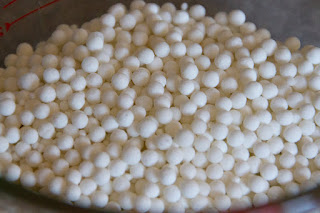This is what tapioca pearls look like before they're added to some of our favorite sweets.
And this is what tapioca looks like before it's been made into cute little pearls.
The photo above is of cassava root (also known as yuca in some parts of the world). It's mainly cultivated and eaten in tropical regions; it started off in Northern Brazil, but eventually made its way across the South American continent and over to Africa and Asia. It's prized for its ability to grow in low-nutrient soils and harvest quickly. It's also loved for its culinary versatility. Cassava can be mashed, cooked into soups or fried into, well, fries. And it's also used to make tapioca. This is what tapioca looks like in flour form.
Tapioca is a starch extracted from the cassava root. It is used as a thickening agent in many foods. It can be made into flour, it has a similar texture to cornstarch which is often times used in gluten-free breads. It can also be made into pearls in varying sizes. (And, it's also the stuff used to iron shirts.)



No comments:
Post a Comment